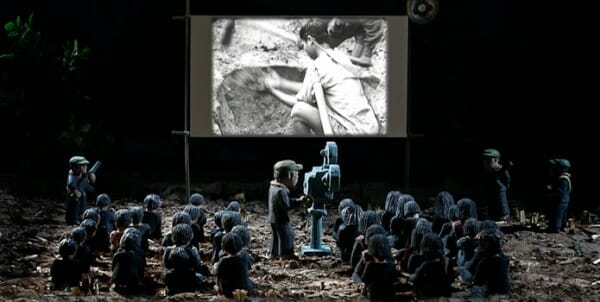
The task of chronicling the unimaginable is handled with great care in The Missing Picture, an affecting documentary about the brutality of Cambodian strongman Pol Pot’s reign. Filmmaker Rithy Panh, who lived through the horrors as a boy, has shaped a compelling story with the help of an intriguing gambit that, while not always successful, forces us to see atrocity in a fresh light.
The Missing Picture, which won the Un Certain Regard prize at this summer’s Cannes Film Festival, gets its name from the notion that Pol Pot’s Khmer Rouge regime sought to bolster its image through propaganda films that soft-pedaled its barbaric treatment of its citizens. Panh, who previously made the documentary S-21: The Khmer Rouge Killing Machine, wants to restore the full picture of a dark era that began in 1975, and he’s chosen to do that by depicting his family’s imprisonment in labor camps through miniature dioramas populated by hand-carved clay figures. These scenes are then juxtaposed with actual propaganda films or recovered footage from the period.
This technique has its downsides. Though the dioramas are striking in their simplicity and the figurines’ melancholy faces convey endless amounts of misery, the novelty of the approach starts to fall away as the movie rolls along. Additionally, the artistry of the dioramas is such that it can sometimes mute the hardships described in The Missing Picture, which include starvation and execution. This representation of that pain is so lovingly and delicately rendered that it can disconnect us from the misery, creating a safe distance that seems antithetical to Panh’s intentions.
With that said, though, the strategy largely works, mostly because Panh has found an effective way of getting around the age old problems facing documentary filmmakers who have to re-create historical moments with actors, often resulting in stagy or hammy scenes. By contrast, the dioramas thrust us into a surreal other world suffused with sadness. These scenes’ hushed solemnity—complemented by Panh’s confessional, diary-like voiceover remembrances—draws us in, rather than pushing us away from the horrors we hear recounted. But those silent clay faces also prove to be a powerful representation of voices muzzled by a repressive regime. Stoic and hard, they become tiny memorials for the people Panh still cannot forget 40 years later.
Much like The Act of Killing, The Missing Picture incorporates a deceptively even-keeled approach to confronting evil. Panh’s film understands that no documentary can undo the injustices that have occurred, but The Missing Picture is a quietly angry rebuke to Pol Pot’s villainy. By not raising its voice, the movie hopes to raise ours so that other such atrocities won’t happen. That even this modest aspiration is unlikely to be realized is yet another sad reality of this despairing film.
Director: Rithy Panh
Writer: Rithy Panh
Screening at the 2013 Toronto Film Festival